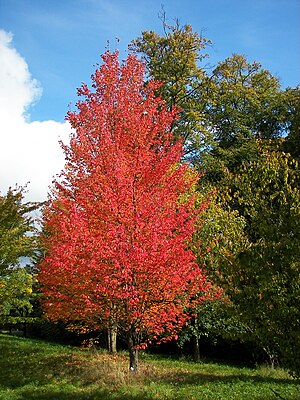Red maple
| Red maple | ||||||||||||
|---|---|---|---|---|---|---|---|---|---|---|---|---|

Red maple ( Acer rubrum ) in autumn colors |
||||||||||||
| Systematics | ||||||||||||
|
||||||||||||
| Scientific name | ||||||||||||
| Acer rubrum | ||||||||||||
| L. |
The red maple ( Acer rubrum ) is a plant species within the soap tree family (Sapindaceae), it has a large distribution area in the temperate zone of eastern North America. The name of the common name and scientific name “red maple” ( Acer rubrum ) is the bright red autumn color. As with sugar maple , the wood is used for furniture, parquet, turning, etc., but is softer than this and is accordingly marketed in North America as “American soft maple”.
In 1964, the US state of Rhode Island named Acer rubrum its landmark (State Tree).
description
Appearance, roots and leaf
The red maple grows as a tree and reaches heights of 20 to 27 meters, in exceptional cases up to 38 meters. In the case of free-standing trees, the treetop is oval and not very dense. The bark of young twigs is green and later turns a shiny brown. On thicker branches and trunks, the bark is initially gray-brown and smooth; on older specimens, a bark with narrow longitudinal furrows develops . By autumn the young seedlings are up to 30 centimeters high.
The root system remains flat below the surface of the earth. In seedlings, the root curves sideways after only 5 centimeters of vertical growth. Most roots do not reach deeper than 25 centimeters, but they are far-reaching and can still be found 25 meters away from the trunk. From the woody, horizontal roots, fiber roots develop upwards, which deeply root through the top soil layer. The root system is very adaptable to different soil conditions and can withstand both drought and floods. The red maple is sensitive to being poured in and compacted.
The relatively small, narrow foliage leaves are five-lobed, whereby the bottom two leaf lobes can only be indistinct. The leaf lobes are directed forward. The diameter of the leaf blade is about 10 centimeters. The leaf margin is serrated, the leaf upper side is dark green in color, the underside is lighter and somewhat bluish or whitish.
Inflorescence, flower and fruit
The flowers appear clearly before the leaf shoots. The flowering period begins in the south of the distribution area in January, in the extreme north from late April to early May. Plants that are very young begin to bloom. There are plants that are monoecious , others have exclusively female or male flowers. The flowers are red and stand together on slender stems in dense inflorescences. The fruits ripen shortly after the leaves shoot and are only able to germinate for a short time.
Chromosome set
The number of chromosomes is 2n = 78, 104 or 26.
distribution
The red maple is common in eastern North America ; there he has a very large area from Florida and the coast of the Gulf of Mexico in the south to the Great Lakes and Newfoundland . It spreads from the Atlantic coast in the east over the Appalachians to the edge of the prairie . In the south of the Appalachian Mountains it rises to an altitude of 1,800 meters, in the north of its range only 600 meters. It is more common in the northern half of its area than in the south and on the edge of the prairie. The red maple is part of the order of the oak-hickory forests (Querco-Caryetalia), but also occurs in forests of the class Pinetea strobi.
The forests in which the red maple occurs are correspondingly diverse. In the north there are mixed forests, where it occurs together with the sugar maple and numerous conifers such as the American red spruce ( Picea rubens ), the balsam fir ( Abies balsamea ) and the Weymouth pine ( Pinus strobus ). Further south there are deciduous forests with deciduous greenery, for example with the American beech ( Fagus grandifolia ), the red oak ( Quercus rubra ) and the tulip tree ( Liriodendron tulipifera ). In the south there are semi-evergreen deciduous trees and various types of pine such as Pinus taeda .
literature
- Helmut Pirc: Maples . Eugen Ulmer, Stuttgart (Hohenheim) 1994, ISBN 3-8001-6554-6 , pp. 201 .
- DA Tirmenstein (1991): Acer rubrum. In: Fire Effects Information System . US Department of Agriculture, Forest Service, Rocky Mountain Research Station, Fire Sciences Laboratory. Online , accessed December 6, 2007.
- Russell S. Walters, Harry W. Yawney (1990): Acer rubrum. In: RM Burns & BH Honkala (Eds.): Silvics of North America, US Department of Agriculture Online , accessed December 6, 2007.
Individual evidence
- ↑ State Trees & State Flowers ( Memento of the original dated December 6, 2010 in the Internet Archive ) Info: The archive link was inserted automatically and has not yet been checked. Please check the original and archive link according to the instructions and then remove this notice. , The United States National Arboretum.
- ↑ a b Erich Oberdorfer : Plant-sociological excursion flora for Germany and neighboring areas. 8th edition. Verlag Eugen Ulmer, Stuttgart 2001, ISBN 3-8001-3131-5 . Page 646.
- ^ Acer rubrum at Tropicos.org. In: IPCN Chromosome Reports . Missouri Botanical Garden, St. Louis



